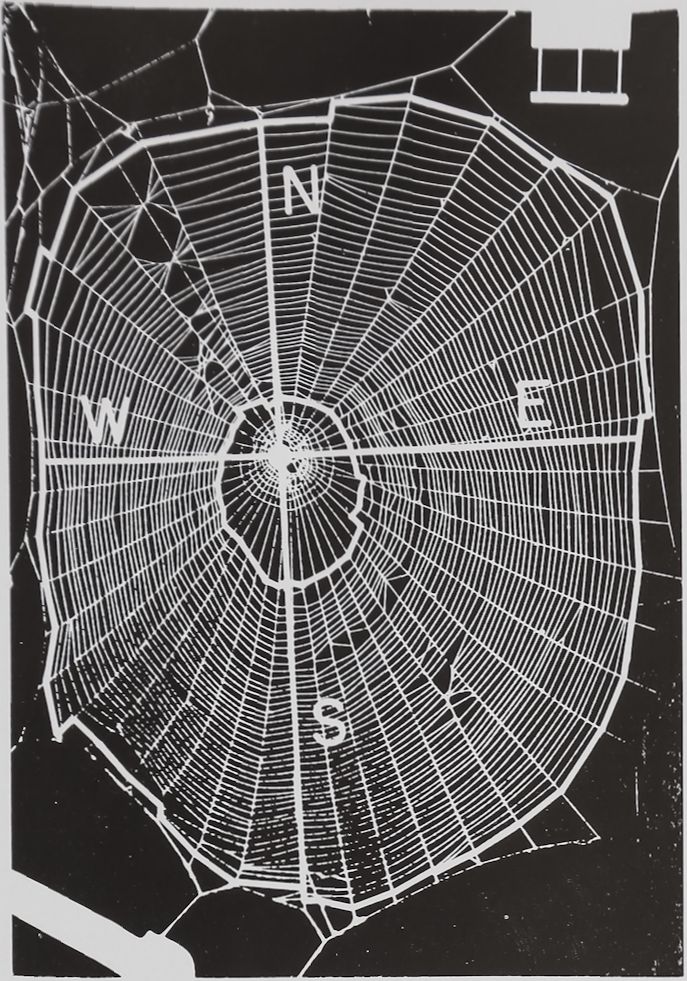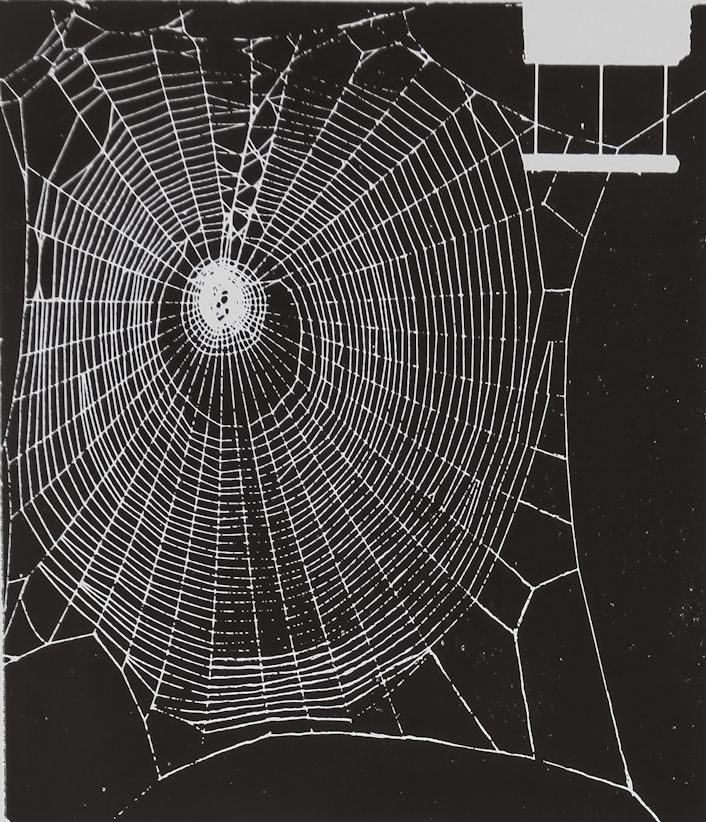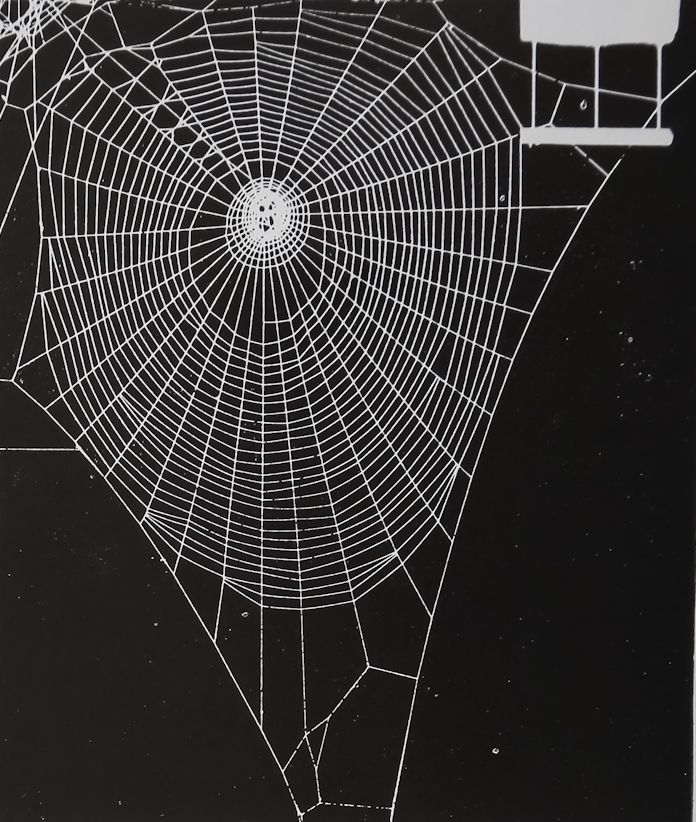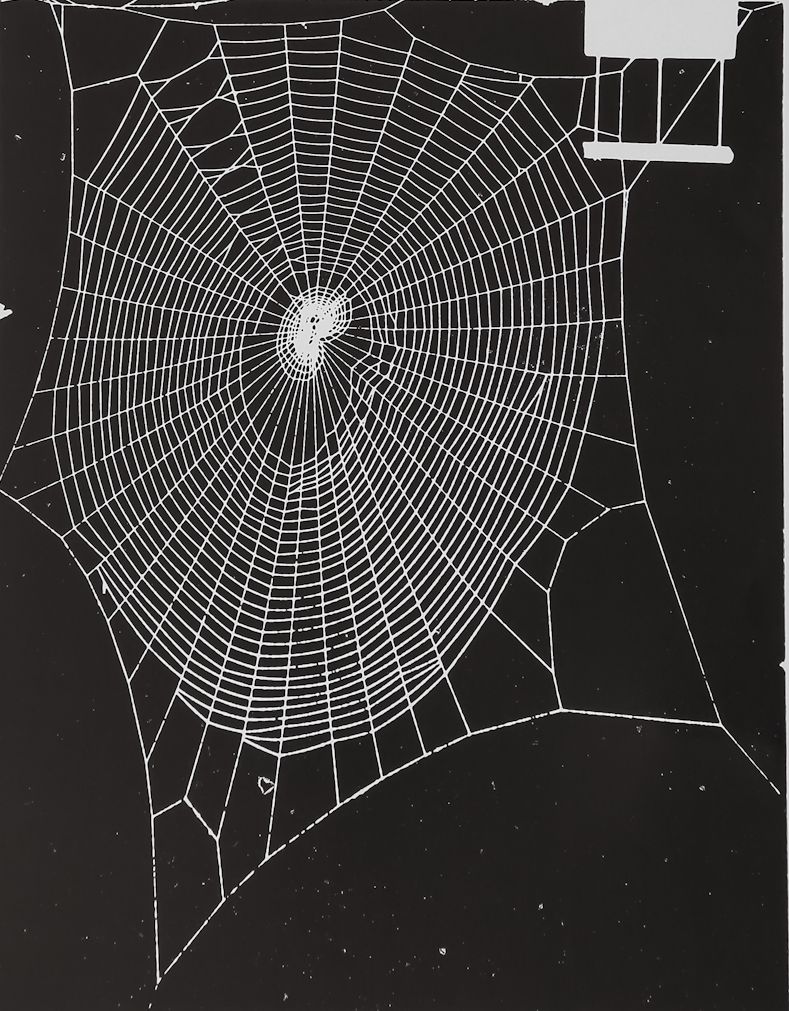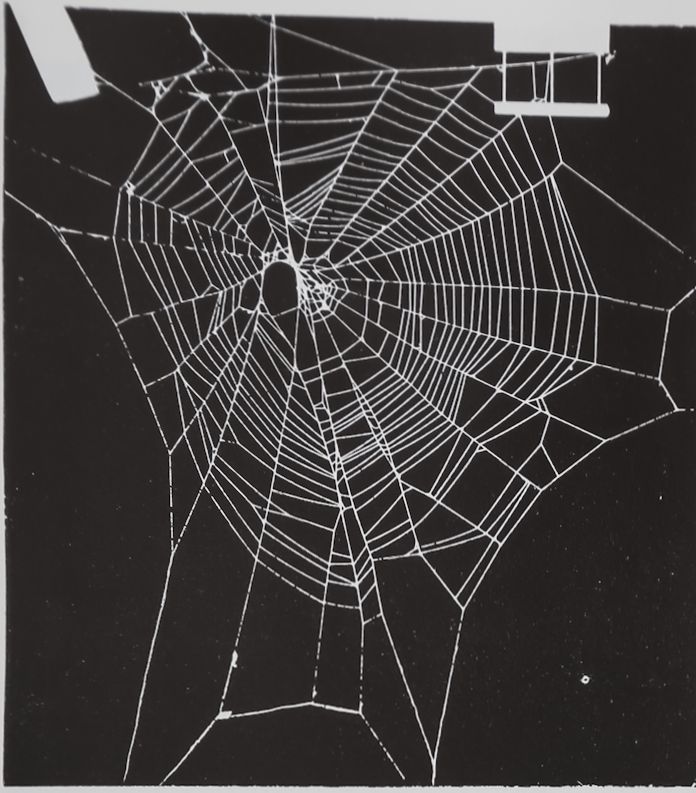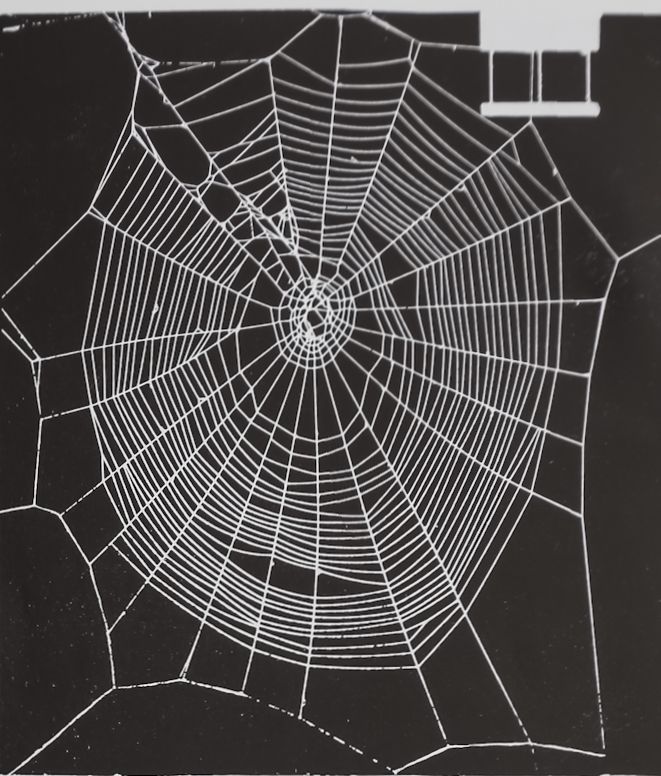Images Collection
View this article in Search Friendly Plain Text
NOTE: This plain text article interpretation has been digitally created by OCR software to estimate the article text, to help both users and search engines find relevant article content. To read the actual article text, view or download the PDF above.
CHANGES IN SPIDER WEBS BROUGHT ABOUT BY MESCALINE, PSILOCYBIN AND AN INCREASE IN BODY WEIGHT
ARNOLD CHRISTIANSEN, RICARDA BAUM and PETER N. WITT
Department of Pharmacology, State University of New York, Upstate Medical Center,
Syracuse, New York
Reprinted from The Journal op Pharmacology and Experimental Therapeutics Vol. 136, No. 1 April, 1962
Copyright © 1962 by The Williams & Wilkins Co. Printed in U.S.A.
Reprinted from Tuw Journal ok Pharmacology and Expiarimiontal Tiibrapioutich Vol, 136, No. 1 April, 1062
Copyright © 1962 by The Williams & Wilkins Co.
Printed in U.S. A.
8726
CHANGES IN SPIDER WEBS BROUGHT ABOUT BY MESCALINE, PSILOCYBIN AND AN INCREASE IN BODY WEIGHT1
ARNOLD CHRISTIANSEN, RICARDA BAUM and PETER N. WITT2
Department of Pharmacology, State University of New York, Upstate Medical Center,
Syracuse, New York
Received for publication September 11, 1961
Reports on the effects of mescaline (Beringer, 1927; La Barre, 1938) and psilocybin (Heim and Wasson, 1958; Isbell, 1959) suggest that the two drugs affect man in a similar way. Both cause changes in pulse rate and respiration, a sensation of heaviness and discomfort, perceptual distortions (especially visual) and hallucinations. Isbell (1959) points out that methods of measurements and the situation in which human experiments are conducted may contribute in some degree to this similarity. The test method which uses the effect of drugs on spiders’ web-building behavior can discern between the actions of a number of similar drugs (Witt, 1956). It appeared therefore an appropriate method for the detection of possible differences in the effects of mescaline and psilocybin.
In previous experiments (Witt, 1956) it had already been established that mescaline is effective in spiders and causes changes in webbuilding. It has also been reported (Witt, 1960) that psilocybin affects web-building. It was, however, necessary to try several doses of both drugs because their potencies are different and similar effects may appear at different doses.
In experiments with growing spiders (Witt and Baum, 1960) it became apparent that certain web changes could be correlated with changes in the spiders’ weight. During the later months of the spiders’ life body weight increased without apparent change in the leg length. In the same period of time the number of spiral turns and radii in the webs decreased without measurable change in the size of the area which was covered by the web. A causal relationship between increasing body weight and decreasing number of spiral
1 This investigation was supported in part by a research grant B-1794 from the National Institutes of Health, U. S. Public Health Service.
2 The skillful technical assistance of Mrs. M. Agi is gratefully acknowledged.
turns and radii was therefore suspected and is investigated in this study. To find out why a heavier spider builds a web with fewer radii and spiral turns our working hypothesis assumed that a heavier spider has to build a thicker thread in order to hold its own weight. If the thread becomes thicker with a limited amount of material being available it necessarily becomes shorter. Preliminary calculations showed that the web of heavier spiders actually was built with a shorter thread.
Surprisingly enough the spiders which had received psilocybin built a shorter thread too. The web changes were similar to those of spiders which carried additional weight. This led to the interpretation that the psilocybin spider behaved as if it were heavier (Witt, 1960). Measurements of thread thickness in weighted and psilocybin spiders would enable one to check such a hypothesis. However, the thickness of threads could not be measured under the microscope because different parts of the web are built with threads of different thickness, threads are not round, and the thickness depends on the tension under which the thread is measured. We therefore calculated thread thickness as total thread length over the weight of the whole web, or as total thread length over the nitrogen content of the web digest. This was done for spiders to which a weight had been added and those which had received psilocybin.
Methods. Procurement of webs. Only the females of the spider Araneus diadematus or Araneus sericatus were used with no preference for age or weight. Experiments were performed all year round in a laboratory with a timed light source (8 hours dark followed by 16 hours light) and temperature regulation (a temperature minimum at the end of the dark period with a 10°C/hour rise at the beginning of the light period). In order to establish the independence of the effects from

Fig. 1. Web of Araneus diadematus Cl.
The thick white circumferential lines bound the area measured for calculation of thread length; N, S, E, W indicate the radii used for evaluation. The irregularities in the upper part of the spiral of this and the following webs indicate the way on which the spider left the web when it was driven away for spraying.
seasonal variation in web-building, experiments with one drug and dose were repeated after 4 to 14 months. In each such double series the results agreed. Webs were built in 20 x 20 inch frames with sliding glass doors, photographed and measured daily as described in earlier papers (Witt, 1956; Witt and Baum, 1960; Witt et al., 1961), or measurements were taken directly from unsprayed webs before these were cut off, weighed and digested for the determination of thread thickness.
Measuring thread length. The glass doors were removed from the spider box and a piece of black cardboard placed behind the box to make the web more easily visible. The number of radii and spiral turns was counted and measurements were taken of the NS and EW diameters (see fig. 1) both of the catching area, determined by the outmost spiral turn, and of the free zone in the center bounded by the innermost spiral. Dr.
Walter Baum3 developed the following formula for us for an approximate calculation of total thread length of the catching area of a web assuming that the spiral consisted of even-spaced perfect circles.
L = nXR + kir(a + R)
in which L equals thread length, n equals number of radii, R equals radius of a circular catching area (N + S + E + W)/4, k equals number of spiral turns counted along S radius, a equals radius of inner circular area (free zone).
Increasing weight of spiders. Eight Araneus diadematus and 5 Araneus sericatus were used in the weight experiments. Two of the spiders were used twice. To 8 Araneus diadematus and 6 Araneus sericatus only adherent was applied. Each spider was weighed the morning after its web was built (“control before” in table 1). A piece of lead equal to 30% of the spider’s weight was placed on the dorsal surface of the abdomen while the spider was held down with a forceps. Ace adherent was used under the lead piece and collodion dissolved in an ether-alcohol mixture over it, sealing the edges. The spider was immobilized until the glue had dried. For controls only the adherent and collodion were used. The web was measured and weighed and the spider returned to its box. After the next web had been built the following night, the weight or adherent was removed by carefully cutting under and around it with small scissors. The first web built after the removal of the weight was again used as control (“1 day later” in table 1). Because spiders of all sizes and weights were used each animal served as its own control. Therefore no comparison of means of figures obtained from different animals is possible (table 1: (1) “control (before)” and “control (3 days later)”).
Measuring web size and regularity of angles. This was done on the photographs which were projected to their original size. A description of the procedure appeared in a previous paper (Witt et al., 1961
Drugs. Crystalline psilocybin from Sandoz Pharmaceuticals4 was dissolved in tap water and enough glucose added to make it taste sweet. One, 2 or 3 drops of 0.01-ml size from a microsyringe were attached to the mouth parts of the spiders. By watching each spider it was ascertained that all fluid was ingested. The spider was weighed and the number of drops and concentration of drug in the drops were adjusted so that each spider got the desired dose =b 10%. Mescaline
3 We are grateful to Dr. Walter Baum at Syracuse University for his help.
4 We wish to thank Dr. R. Bircher at Sandoz Pharmaceuticals for a liberal supply of crystalline psilocybin.
TABLE 1
Comparison of thread length and thickness (the latter measured by relating thread length to web nitrogen content) in spider webs directly before and after different treatments For statistical evaluation each animal served as its own control. There were significant reductions (below the 1% probability level) in thread length after treatment only in groups 1, 3, 4 and 8 (*), a significant increase in thickness (P < .01) in 1 (**) and a significant decrease at the 2.6% probability level in 3. Experiments in group 4 were done 14 months after those in group 3. Length and thickness of threads in control webs depended on the size and weight of spiders, but the effect of treatment seemed independent of this.
| Treatment | No. of Webs Measured | Average Thread Length (m) and Standard Error of the Mean | No. of Webs Measured | Average ßg Protein/m Thread and Standard Error of the Mean |
| 1) Control (before) | 15 | 15.95 ± 1.69 | 13 | 11.5 ± 2.1 |
| Plus 30% weight | 15 | 10.76* =t 0.95 | 11 | 22.6** ± 5.4 |
| Control (1 day later) | 14 | 9.86* ± 0.85 | 10 | 21.3** ± 7.1 |
| Control (3 days later) | 14 | 12.25 ± 0.95 | 7 | 14.1 ± 1.5 |
| 2) Control (before) | Bl2 | 16.41 d= 2.25 | 10 | 14.0 ± 3.2 |
| Adhesive | 12 | 14.24 ± 1.34 | 12 | 20.5^: 6.7 |
| 3) Control (before) | 9 | 19.05 it 2.74 | 9 | 36.9 ± 4.9 |
| Psilocybin 150 mg/kg | 9 | 13.80* ® 1.30 | 9 | 29.5 ± 5.1 |
| 4) Control (before) | 23 | 18.39 ± 1.19 | ||
| Psilocybin 150 mg/kg | 23 | 14.30* ± 0.99 | ||
| ControTfl day later) | 21 | 15.25 ±1.17 | ||
| 5) Control (before) | 7 | 20.59 ± 4.52 | ||
| Psilocybin 300 mg/kg | 7 | 14.51 ± 2.86 | ||
| 6) Control (before) | 25 | 21.93 ±1.16 | ||
| Mescaline 250 mg/kg | 25 | 19.88 ± 1.75 | ||
| 7) Control (before) | 7 | 17.55 ± 2.28 | ||
| Mescaline 500 mg/kg | 7 | 13.93 ± 1.28 | ||
| 8) Control (before).^ | 32 | 14.01 ± 0.83 | ||
| Mescaline 1 g/kg | 32 | 9.91* ± 0.69 |
hydrochloride crystalline was obtained from Hoffmann-La Roche Inc. It was dissolved and given to the animals in the same way as described above.
Weighing the web. The catching area was cut free of the web frame. As the radii were severed, just outside the outer spiral thread, the web collapsed into itself so that finally it appeared as one line attached at both ends to the last intact radii. One end was then attached to the top of the frame with a piece of tape, and the other end cut free. The web was folded upward from the free end onto filter paper low in nitrogen which had been cut into small discs weighing between 3 and 6 mg. The disc was weighed, the web added and the disc plus the web reweighed on a Cahn electromagnetic balance sensitive to 1 jug. It was then placed into a test tube in preparation for nitrogen determination.
Nitrogen microdetermination. Webs on filter paper were digested according to Koch and McMeekin (1924). The ammonia was distilled from the digest in a microstill according to Jenden
and Taylor (1953). The distillate was nesslerized and compared to nitrogen standards in a Klett colorimeter. The figures were expressed as protein under the assumption that protein contains 16% nitrogen.
Results. Thread length. It can be seen from table 1 that the total thread length in a spider’s web decreased significantly if the weight of the animal was increased about 30% or psilocybin 150 mg/kg or mescaline 1 g/kg was given. The small number of experiments with 300 mg/kg psilocybin made the thread significantly shorter only at the 5% probability level. The adhesive with which the weight was fastened to the spider’s back did not cause a significantly shorter thread if attached alone. After the lower dose of 500 mg/kg mescaline no significant shortening of the thread was apparent. But such an effect cannot be excluded because of the small number of experiments at that dose level. An even lower dose of 250 mg/kg mescaline showed no meas-
TABLE 2
Relative regularity of angles in spider webs before and after drug application The results were obtained by dividing the figure for the regularity in the drug web of each spider by the figure obtained from the same animal’s control web on the previous day. A figure of 1 indicates no change while figures above 1 indicate a decrease in regularity after the drug. The only statistically significant decrease in regularity below the 1% probability level was observed after 1 g/kg mescaline(*).
| Drug | Dose
(g/kg) |
No. of Drug Webs | Mean, Relative Regularity of Angles | Standard
Error |
| Psilocybin | 0.15 | 23 | 1.14 | ±0.10 |
| Psilocybin | 0.30 | 5 | 1.13 | ±0.18 |
| Mescaline | 0.05 | 6 | 0.98 | ±0.26 |
| Mescaline | 0.10 | 14 | 1.10 | ±0.13 |
| Mescaline | 0.25 | 25 | 1.30 | ±0.11 |
| Mescaline | 1.0 | 32 | 1.46* | ±0.15 |
urable shortening effect in a large number of webs. It appears, therefore, that the shortening effect is dose-dependent, and the change after 150 mg /kg psilocybin can be compared to a change after 500 to 1000 mg/kg mescaline.
Recovery. Removing the weight did not result in a longer thread the following day. It appeared to require 3 days for the thread to reach control values. In contrast, most of the spiders which had spun a shorter thread after psilocybin had recovered the next day so that their thread was no longer significantly shorter than controls (table 1).
Thread thickness. According to our hypothesis the heavier spider makes a thicker thread which has to be shorter because there is not enough material to make a thicker thread of equal length. Table 1 supports such an assumption by showing that the amount of protein per meter thread had increased in the heavier spiders. The weight had increased too but the difference was not significant. The fact that only the protein values were significantly increased at the 1% level indicates that this was the more exact way of determination. Again, as with thread length, the spiders did not recover immediately after the removal of the weights but took 3 and more days. The results of the adhesive experiment show that it was the weight and not the chemical used to
attach it which caused the thicker thread. The shorter thread built by the psilocybin spiders was not thicker. The mean weight per thread was even lower than controls, but the difference was significant only at the 2.6% level.
Other web proportions. If we had measured only thread length we might have assumed that mescaline 1 g/kg and psilocybin 150 mg/kg cause web changes equal to those after body weight increase. Table 2 provides additional data from web measurements showing that while the spiders after psilocybin built webs which did not differ in regularity of angles from controls, the angles after mescaline became significantly more irregular. This becomes also apparent if we compare figures 2B and 3A. A lower dose of mescaline (250, 100 or 50 mg/kg) no longer caused a significant change in the regularity of angles indicating that this effect depends on the dose in the same range as the thread shortening. The webs after Hg/kg mescaline were also significantly smaller than controls below the 1% probability level while lower doses of mescaline as well as any dose of psilocybin showed no such effect.
Web-building frequency. Table 3 permits a comparison of the effects of mescaline and psilocybin on web-building frequency. Any dose of psilocybin above 150 mg/kg significantly decreased (P < .01) or totally suppressed webbuilding, while even after 1 g/kg mescaline the web-building frequency was not significantly decreased. The few webs built after high doses of psilocybin showed no indication of irregularities in angles. If the effect on web-building frequency is compared a psilocybin dose between 150 and 300 mg/kg was as effective as a mescaline dose between 1 and 5 g/kg. Additional weight, even in excess of 30%, did not decrease web-building frequency significantly.
Discussion. Both mescaline and psilocybin made the spider spin a shorter thread. Each drug has this effect in a different dose range. The relationship between the potency of both drugs is about 1 to 10 in spiders, psilocybin being the more potent drug. A similar ratio in effective doses of 1 to 10 can be calculated for the effect on web-building frequency, taking into consideration that a mescaline dose exceeding 1 g/kg as well as a psilocybin dose exceeding 100 mg/kg reduced frequency.
Measurements of thread length and web-building frequency alone would suggest that
Fig. 2 A (above, left). Control web built by a spider in the morning before psilocybin application.
B (above, right). This web was built by the same spider as 2A, 24 hours later. Twelve hours before web-building time it had received 150 mg/kg psilocybin by mouth. The web shows a smaller number of radii and spiral turns than 2A and a shorter thread. C (below). This web was built by the same spider as 2A and 2B, 24 hours later than 2B. It shows the nearly complete recovery of the animal from the drug effect.




Fig. 3 A (left). A web built by the same animal as in figure 1, 24 hours later.
The spider had received 1 g/kg mescaline 12 hours before web-building time. This web is smaller, has a shorter thread and more irregular angles than that in figure 1. B (right). Twenty-four hours later the spider of figures 1 and 3A is partly recovered. The web is, except for the size, no longer different from control.
TABLE 3
Web-building frequency of spiders after different doses of psilocybin and mescaline The frequency was significantly decreased below the 1% probability level after 0.3, 0.6 and 6.0 g/kg of psilocybin and after 5.0 g/kg of mescaline. The web-building frequency of control spiders was 50%.
| Drug | Dose
(g/kg) |
No. of Spiders in Expt. | % Animals Which Built a Web after the Drug |
| Psilocybin | 0.15 | 46 | 54 |
| Psilocybin | 0.3 | 85 | 11 |
| Psilocybin | 0.6 | 40 | 5 |
| Psilocybin | 6.0 | 33 | 0 |
| Mescaline | 0.05 | 12 | 50 |
| Mescaline | 0.1 | 30 | 47 |
| Mescaline | 0.25 | 43 | 60 |
| Mescaline | 0.5 | 15 | 47 |
| Mescaline | 1.0 | 81 | 38 |
| Mescaline | 5.0 | 10 | 0 |
psilocybin and mescaline have similar effects in spiders. Our method of testing the drug effects on web-building has, however, the advantage of permitting us to compare additional parameters.
The web size as well as the regularity of angles is differently affected by both drugs, mescaline alone causing smaller and less regular webs. This indicates that mescaline interferes with motor behavior at a dose at which web-building is still possible, while psilocybin does not change regularity as long as webs are built at all. Such differential effects are reminiscent of chlorpromazine versus pentobarbital changes in web-building. While the tranquilizer diminishes web-building frequency without causing irregular webs, the barbiturate can be given in a dose where it causes smaller and irregular webs (Witt, 1961). An interpretation that psilocybin interferes first with web-building drive before it affects motor behavior is suggested. There exists some confirmation for such interpretation in the experiments of Weidmann et al. (1958) who found that psilocybin decreased spontaneous activity in mice, and Monnier (1959) who observed behavior quieter than normal in rabbits. Mescaline, in contrast, would interfere with motor coordination first and resembles in that respect more the effects of d-amphetamine on web-building (Witt ct a/., 1961).
A tentative explanation of the change which

the drug brings about in the spider was tried by comparing webs from spiders with added weights with webs built after psilocybin. We found evidence for the hypothesis that a heavier spider builds a thicker thread which it probably does to hold its increased weight. It may be that it does not have enough material to build a full length thread. But the psilocybin spiders built a thread which was shorter but not thicker than the controls. This makes it unlikely that spiders behaved as if they were heavier after psilocybin. An effective dose of the drug seems not to affect the potentials which can be picked up from the vibration receptor (C. Walcott, personal communication, 1960) which might have a regulatory influence on thread thickness. Psilocybin may have an inhibitory effect on silk production, a possibility which is presently being investigated.
While web-building recovers from the effects of psilocybin and mescaline on the following day the removal of weight has no such immediate effect. For about 3 days, varying from animal to animal, the thread remained shorter and thicker but recovered always later. This could indicate that the mechanism which couples recognition of body weight to regulation of thread thickness is no simple reflex. The possibility is not excluded that cutting the weight off did some damage which was only slowly repaired.
By comparing all measured parameters it was possible to establish that the two drugs and the addition of weight changed web-building in three different ways. This is further evidence for the possibility of distinguishing between a number of influences with the web test.
SUMMARY
One hundred and fifty mg/kg of psilocybin per os, 1 g/kg of mescaline per os, or a 30% increase in body weight made spiders build webs the following day with a shorter thread. The weight increase also caused a thicker thread measured as higher nitrogen content per meter thread. This can be explained by assuming that the heavier spider has to build a thicker thread to hold its own
weight while it has not enough material to build it of equal length. Removal of weight led only after 3 and more days to a return to thread thickness and length of control webs. However, these heavier spiders repeated their web-building at a normal frequency.
The shorter thread after psilocybin application was not thicker nor were any changes in web proportions observed. Further increase in the dose of psilocybin caused a dose-dependent decrease in web-building frequency, and none out of 33 spiders which had received 6 g/kg psilocybin built a web on the following day. This may be comparable to the relaxing effect of psilocybin in higher animals or be attributed to an effect on thread production. The mescaline webs with shorter threads also showed a smaller catching area and more irregular angles. A higher dose diminished web-building too. The ratio between effective doses of mescaline and psilocybin was about 1:10 measured as changes in thread length or web-building frequency, with psilocybin being the more potent drug.
REFERENCES
Beringer, K.: Der Meskalinrausch, seine
Geschichte und Erscheinungsweise, Springer Verlag, Berlin, 1927.
Heim, R. and Wasson, R. G.: Les Champignons Hallucinogénes du Mexique. Editions du Muséum National d’Histoire Naturelle, Paris, 1958.
Isbell, H.: Psychopharmacol. 1:29,1959.
Jenden, D. J. and Taylor, D. B.: Analyt. Chem.
25 : 685, 1953.
Koch, F. and McMeekin, T. L.: J. Amer. chem.
Soc. 46: 2066, 1924.
La Barre, W.: The Peyote Cult, Yale University Press, New Haven, 1938.
Monnier, M.: Experientia 15: 321, 1959. Weidmann, H., Taeschler, M. and Konzett, H.: Experientia 14: 378, 1958.
Witt, P. N.: Die Wirkung von Substanzen auf den Netzbau der Spinne als biologischer Test, Springer Verlag, Berlin, 1956.
Witt, P. N.: Pharmacologist 2: no. 2, 63,1960. Witt, P. N.: Tranquilizers, Experimental Proof for Their Specific Effects, Transactions and Studies of the College of Physicians of Philadelphia 29: 9, 1961.
Witt, P. N. and Baum, R.: Behaviour 16: 309, 1960.
Witt, P. N., Brettschneider, L. and Boris, A. P.: This Journal 132:183,1961.
